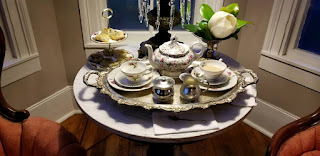 |
Highclere Castle values its gardens as much as its interiors,
much the way that Southerners value their gardens.
|
Recently the royal wedding triggered a line of thought that
has been traipsing through my mind for many years, and that is the close
connections between Southerners and the British. Of course we know that the
South was settled largely by the British. Many of the plantations of the South
were originally land grants from the kings of England. But even if you cannot
trace your family’s history back to its British roots, you can trace some of
the South’s culture back to the United Kingdom and, thereby, explain some of
our…tendencies.
When visiting the United Kingdom last year, I was taken
aback by the ubiquitous use of the word “proper.” There seemed a proper way of
doing everything—as exampled always by the rules of royalty. Though much of the
South has taken on a more casual way of living, make no mistake about it, doing
things the “proper” way is still the preferred way to many Southerners.
First of all, we (who notice) are like the British in our
formal behaviors and manners. Dining,
sitting, introductions, decorating—all have protocol. Though they were too
gracious to call us out on our American dining habit of switching our forks and
knives when we ate, we caught the way the British looked at us. Though we eat
with our forks upturned in our right hands and don’t ascribe to pushing our
peas with a knife onto an upside down fork in our left hand, we have our own
standards for manners when dining and interacting with others, and like the
British, we would never call people out for putting their elbows on the table
or for eating and talking at the same time. There is simply a way to behave in “proper”
society, and then there is…the improper way. Though our “rules” may differ
slightly, propriety is the overarching theme for both cultures.
Dressing for the British and for “proper” Southerners is a
more formal affair, as well. The British love their tweed and wool from the Cotswalds,
and we ladies from the South love our Lilly Pulitzer dresses, but what we both
have in common is our united sense of dressing conservatively and well. We have
a sense of what is proper to wear where and when. And though it’s not always
adhered to, the rule in the South about not wearing white before Memorial Day
and after Labor Day is still on the books for many in the old guard. Do I even
need to point out our affinity for pearls? And nowhere is the similarity more
evident than when dressing our children. We Southerners decorate our young
children with smocked dresses, shorts suits and outfits made of heirloom
stitching, and we slap bows the size of our little girl’s heads in their hair.
We have a sense of fine fabrics, cardigans, and “proper” shoes for our little
ones, as well. Just take a look at the royals—if you’re in doubt.
 |
| Southerners love tea and silver as much as the British. |
The foods and beverages we consume in the South have British
roots, too, though some may not fully understand. Our meat puddings, like liver
pudding and hog’s head cheese, have their beginnings in merry old England,
where meat pies and puddings are staples. Have you ever eaten black pudding? In
the South, we call it blood pudding. And do I even need to mention the
connection we have with tea? It is an everyday staple for Southerners and the
British. Though we have morphed our consumptions (sweet iced tea for us and
cream tea for the UK), the unifying part is the tea.
Where do you think we get our love for hunting? That’s
right, Great Britain! The list is long: Fishing is a religion. We look for
occasions to pull out and use our best silver. We love our Southern gardens,
Southern gates, and Southern architecture—all of which harken to the United
Kingdom. Our churches and our faith are serious business. Like the British, we
go overboard naming our children with family names. We love to decorate our
homes with English antiques or antiques that embody British aesthetics. We name
our houses, gardens and lands like the British-Middleton Place Gardens, Charles
Towne Landing, and Drayton Hall, just to name a few.
I’m not saying that some of these influences cannot be
linked to other regions of America, but the fact that the traditions are
magnified tenfold in the South cannot be disputed.
To further my point about our connections, I can direct you
to my favorite Southern magazine, Garden
and Gun, which is planning a trip for subscribers to Great Britain to
celebrate all the things we have in common. The South’s execution of some of
these traditions may be slightly different; however, our connection to the
British is undeniable. Southerners have British roots that have grown deep and
wide in this warm Southern soil!

